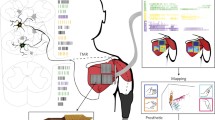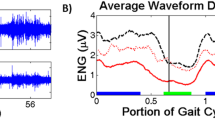Abstract
Inherent limitations of the surface myoelectric signal, such as the lack of recording sites in high-level amputations, and the sensitivity to placement and impedance effects, confound its wider application in powered prostheses. Since a functionally topographic distribution (somatotopic organization) of nerve fascicles exists within the peripheral nerves, it is theoretically possible that complete motor control information can be retrieved from peripheral nerve signals. In this study, we present a computational model that simulates the recording from specific nerve fascicles in the upper limb during voluntary contractions while they innervate relevant muscles. A procedure of classifying the nerve data is presented using a set of time domain features and a spike detection algorithm. Recommendations are made to achieve optimal neural signal recognition, with regard to electrode geometry and signal analysis.









Similar content being viewed by others
Notes
We have attempted to simplify the concept of encapsulation for this initial study. Although encapsulation is a continuous process of fibrous tissue surrounding the electrodes, resulting in decreasing signal amplitudes over time, it was desirable to have a single metric to describe the degree of encapsulation. By assuming that an electrode either experience no encapsulation (ON) or is fully encapsulated (OFF), we can describe the degree of encapsulation as the percentage of those that are OFF. We feel that, although not completely accurate, this approach will produce results that are very similar to those with continuous degradation of signal amplitude, assuming that neurons in each channel are either detectable or not.
By defining the “signal” as the AP peak at the recording boundary, this presents the “worst-case scenario” in defining the SNR.
References
Abrams RA, Ziets RJ, Lieber RL, Botte MJ (1997) Anatomy of the radial nerve motor branches in the forearm. J Hand Surg 22(2):232–237
Bonnel F (1985) Histologic structure of the ulnar nerve in the hand. J Hand Surg 10(2):264–269
Bonnel F, Mansat M, Villa MA (1982) Anatomical and histological basis of surgery to the radial nerve. Anat Clin 3(3):229–238
Boutros S, Nath RK, Yüksel E, Weinfeld AB, Mackinnon SE (1999) Transfer of flexor carpi ulnaris branch of the ulnar nerve to the pronator teres nerve: histomorphometric analysis. J Reconstr Microsurg 15(2):119–122
Branner A (1999) Selective stimulation and recording using a slanted multielectrode array. In: Proceedings of the first joint BMES/EMBS conference. 1999 IEEE engineering in medicine and biology 21st annual conference and the 1999 annual fall meeting of the Biomedical Engineering Society (Cat. No. 99CH37015), vol 1, p 377
Branner A, Normann RA (2000) A multielectrode array for intrafascicular recording and stimulation in sciatic nerve of cats. Brain Res Bull 51(4):293–306
Buerkle VR (2006) Advanced pattern recognition concepts for an artificial shoulder. Master Dissertation, Department of Electrical and Computer Engineering, University of New Brunswick
Couch LW (1997) Digital and analog communication system, 5th edn. Prentice Hall, Upper Saddle River
Dhillon GS, Lawrence SM, Hutchinson DT, Horch KW (2004) Residual function in peripheral nerve stumps of amputees: implications for neural control of artificial limbs. J Hand Surg 29(4):605–615
Donoghue JP (2002) Connecting cortex to machines: recent advances in brain interfaces. Nat Neurosci 5(Suppl):1085–1088
Elgafy H, Ebraheim NA, Yeasting RA (2000) The anatomy of the posterior interosseous nerve as a graft. J Hand Surg 25(5):930–935
Englehart K, Hudgins B (2003) A robust, real time control scheme for multifunction myoelectric control. IEEE Trans Biomed Eng 50(7):848–854
Gozani SN, Miller JP (1994) Optimal discrimination and classification of neuronal action potential waveforms from multiunit, multichannel recordings using software-based linear filters. IEEE Trans Biomed Eng 41(4):358–372
Guillory KS, Normann RA (1999) A 100-channel system for real time detection and storage of extracellular spike waveforms. J Neurosci Methods 91(1–2):21–29
Hargrove L, Englehart K, Hudgins B (2007) A comparison of surface and intramuscular myoelectric signal classification. IEEE Trans Biomed Eng 54(5):847–853
Hudgins B, Parker P, Scott RN (1993) New strategy for multifunction myoelectric control. IEEE Trans Biomed Eng 40(1):82–94
Jiang N, Englehart KB, Parker PA (2007) A simulation method for the firing sequences of motor units. J Electromyogr Kinesiol 17(5):527–534
Johnston W, Stewart J (1990) Sciatic neuropathies: a 10 year experience. Can J Neurol Sci 17:249
Lawrence SM, Dhillon GS, Jensen W, Yoshida K, Horch KW (2004) Acute peripheral nerve recording characteristics of polymer-based longitudinal intrafascicular electrodes. IEEE Trans Neural Syst Rehabil Eng 12:345–348
Lewicki MS (1998) A review of methods for spike sorting: the detection and classification of neural action potentials. Netw Comput Neural Syst 9(4):53–78
Li S, Gu L, Shao Y, Sun T (2006) Distribution and localization of fascicular groups to intrinsic muscles of ulnar nerve trunk. Chin J Clin Rehabil 10(24):117–119
Naples GG, Mortimer JT, Scheiner A, Sweeney JD (1988) A spiral nerve cuff electrode for peripheral nerve stimulation. IEEE Trans Biomed Eng 35:905–916
Nikolic ZM, Popovic DB, Stein RB, Kenwell Z (1994) Instrumentation for ENG and EMG recordings in FES systems. IEEE Trans Biomed Eng 41(6):703–706
Normann RA, McDonnall D, Clark GA (2005) Control of skeletal muscle force with currents injected via an intrafascicular, microelectrode array. In: Engineering in Medicine and Biology Society, 2005. IEEE-EMBS 2005. 27th annual international conference, pp 7644–7647
Rousche PJ, Normann RA (1998) Chronic recording capability of the utah intracortical electrode array in cat sensory cortex. J Neurosci Methods 82(1):1–15
Schady W, Ochoa J, Torebjork H (1983) Peripheral projections of fascicles in the human median nerve. Brain 106:745–760
Sunderland S (1978) The median nerve anatomical and physiological features. In: Sunderland S (ed) Nerves and nerve injuries. Churchill Livingstone, Edinburgh, pp 656–690
Sunderland S (1991) Numbers of nerve fibers for individual branches. In: Sunderland S (ed) Nerve injuries and their repair: a critical appraisal. Churchill Livingstone, Edinburgh, pp 41–45
Tung THH, Mackinnon SE (2001) Flexor digitorum superficialis nerve transfer to restore pronation: two case reports and anatomic study. J Hand Surg 26(6):1065–1072
Weir RFf (2002) Design of a clinically viable multifunctional prosthetic hand. In: 2002 Myoelectric controls conference, Fredericton, NB, Canada
Weir RF, Troyk PR, DeMichele G, Kuiken T (2003) Implantable myoelectric sensors (IMES) for upper-extremity prosthesis control-preliminary work. In: Engineering in Medicine and Biology Society, proceedings of the 25th annual international conference of the IEEE, vol 2, pp 1562–1565
Yoshida K, Horch K (1994) Control of ankle position using neural feedback. In: Annual international conference of the IEEE engineering in medicine and biology—proceedings, vol 16, issue pt 1, pp 414–415
Yoshida K, Stein RB (1996) Development of chronic longitudinal intrafascicular electrodes. In: Proceedings of the 18th annual international conference of the IEEE engineering in Medicine and Biology Society, vol 1, Issue 31 Oct–3 Nov 1996, pp 373–374
Yoshida K, Kurstjens M, Citi L, Koch KP, Micera S (2007) Recording experience with the thin-film longitudinal intra-fascicular electrode, a multichannel peripheral nerve interface. In: IEEE 10th international conference on rehabilitation robotics, vol 1, Issue 13–15 June 2007, pp 862–867
Zhao X, Lao J, Hung L, Zhang G, Zhang L, Gu Y (2004) Selective neurotization of the median nerve in the arm to treat brachial plexus palsy. J Bone Joint Surg 86A:736–742
Zhong S, Liu M, Tao Y (1981) A study of the microsurgical anatomy of the ulnar nerve. Acta Anat Sin 12:346–354
Zhou R, Jiang N, Englehart E, Parker P (2008) A computational model of nerve model of nerve signal detection and recognition during voluntary muscle contractions. In: 31st Canadian medical and biological engineering conference (CMBEC31), Montreal
Author information
Authors and Affiliations
Corresponding author
Rights and permissions
About this article
Cite this article
Zhou, R., Jiang, N., Englehart, K. et al. A computational model and simulation study of the efferent activity in the brachial nerves during voluntary motor intent. Med Biol Eng Comput 48, 67–77 (2010). https://doi.org/10.1007/s11517-009-0555-8
Received:
Accepted:
Published:
Issue Date:
DOI: https://doi.org/10.1007/s11517-009-0555-8




